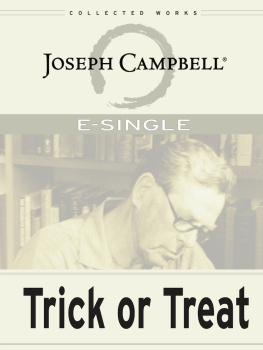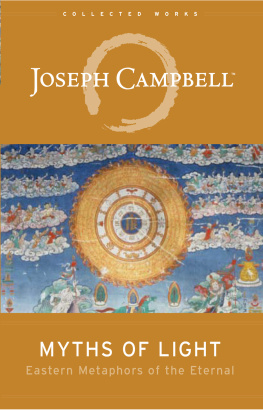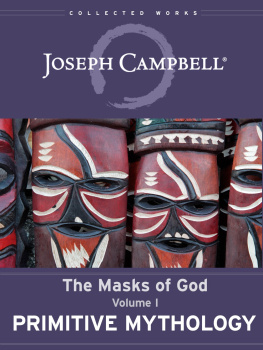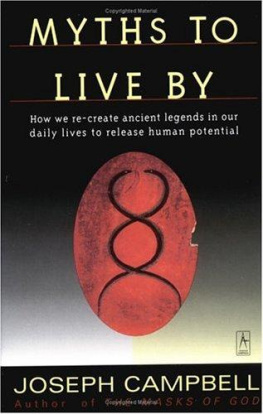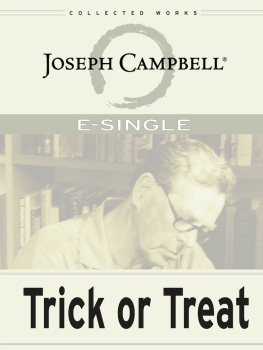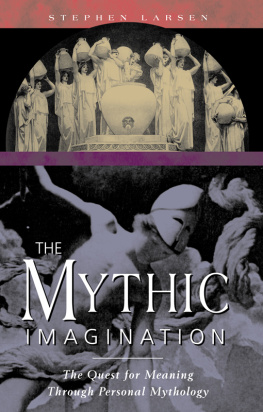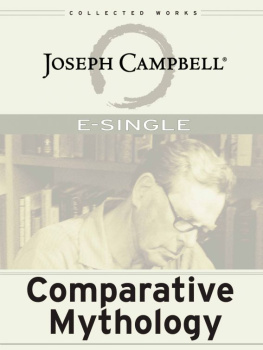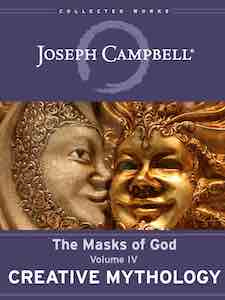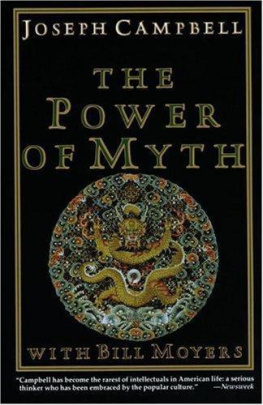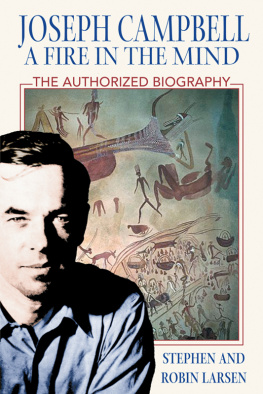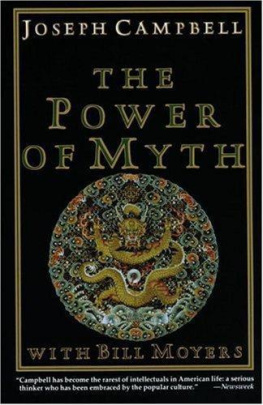To know others is wisdom;
To know yourself is enlightenment
To master others requires force;
To master yourself requires true strength.
Lao-tzu, Tao-te Ching, chapter 33

CONTENTS

EDITORS FOREWORD
Joseph Campbell said in 1972, while he was compiling his book Myths to Live By from two decades worth of lectures, that he experienced a revelation:
My notion about myself was that I had grown up during that time, that my ideas had changed, and, too, that I had progressed. But when I brought these papers together, they were all saying essentially the same thingover a span of decades. I found out something about the thing that was moving me. I didnt even have a very clear idea of what it was until I recognized those continuities running through that whole book. Twenty-four years is a pretty good stretch of time. A lot had happened during that period. And there I was babbling on about the same thing.
As I compiled this book, which is drawn from over a dozen lectures, interviews, and seminars that Campbell gave between 1962 and 1983, I had a very similar impression.
I had culled all of these lectures because they traced Campbells exploration of the idea of mythology as a tool for promoting and understanding the psychological growth of the individualwhat he called the fourth or psychological function of myth. My first thought was to present a sort of historical overview of Campbells thoughts on the subject.
And yet I found that the ideas that he was expostulating at the end of the period in which he was finishing his Cooper Union lectures and the gargantuan Masks of God series were indeed very much in line with those that he was continuing to explore close to the end of his life, albeit in more informal, intensive settings, such as the workshops at the Esalen Institute with which he celebrated his birthday every year. Some of his thinking grewhis feelings about the promise and dangers of LSD as a gateway to unlocking the mythic images of the collective unconscious, for example yet the overall thesis remained the same. He felt that myth offered a framework for personal growth and transformation, and that understanding the ways that myths and symbols affect the individual mind offered a way to lead a life that was in tune with ones naturea pathway to bliss.
The slow elaboration of his thoughts has made editing this volume both infinitely easier and infinitely more difficult than editing the previous volumes of The Collected Works of Joseph Campbell series that I have worked on. Sake & Satori: Asian JournalsJapan was drawn from a single, sequential source, which allowed me to concentrate on making sure that Campbell was telling his story well. Myths of Light: Eastern Metaphors of the Eternal was based on a number of lectures and unpublished writing, covering thirty years of Campbells thinking on Indian and East Asian religion, but once I had sorted the topics into a form that made sense as an exploration of the idea of the transcendent divine, each section fell into place fairly cleanly, one lecture to a section.
The first section of the current volume, Man and Myth, looks at the historical development of myth as a tool for the growth, not of societies, but of individuals. This section was drawn from a similarly diverse set of lectures; my main task in presenting them was to make sure that any redundancies were eliminated, so that the reader wasnt treated to four separate rehearsals of the four functions of mythology, for example.
The second section, however, Living Myth, focuses on the fundamental psychology of myth, and was drawn from a series of presentations delivered over the course of almost a decade, all entitled Living Your Personal Myth (a title which Campbell himself was never fully comfortable with). Sometimes this was an hour-long lecture, sometimes a week-long seminar. In each case, the topics covered shared a similar approach yet were presented in different order, with different emphasis, depending on Campbells audience, then-current events, and his own developing thoughts on the subject. This made piecing together an intelligible but full exploration of his ideas more than usually challenging.
The third section, entitled The Heros Journey, explores the basic premise set forth in Campbells seminal work The Hero with a Thousand Faces as a tool for looking at ones own life. It presented yet another challenge. Most of this material was drawn from a three-day segment of a month-long seminar in 1983. Since the entire seminar took place in the form of an extremely free-form, wide-ranging discussion, its shape was extremely diffuse. Finding a narrative thread without either imposing a thesis or reducing the exploration to the point of incomprehensibility was challenging, to say the least. This was probably the most difficult, humbling experience of all.
One of the joys of readingand editingJoseph Campbells work is that his mind, like Indras net of gems, ties one glistening jewel of thought to another, always finding the connecting thread. As I said in the introduction to Myths of Light, the remarkable conceptual leaps in this volume you may attribute to Campbell. Any lapses of logic you may lay solely at my feet.
It is important to note that my contribution in bringing this book to life is but one of many. I would like to acknowledge the tireless work of JCF president Robert Walter, who has not only kept Campbells legacy alive in the seventeen years since his death, who not only manages the small but thriving not-for-profit corporation that has kept Campbells work moving forward, but who also helped me sort through crates of transcripts and audiotapes, drawing on his own experience as Campbells friend and editor in searching for just the right material for this book.
I would also like to acknowledge the continued efforts of Jason Gardner of New World Library, who has been our partner in bringing this wonderful, growing series to life, and of Mike Ashby, who has barely broken a sweat when confronted by Sanskrit, Japanese, and Finnegans Wake.
I wish to acknowledge, too, the contributions of Sierra Millman and Shauna Shames, brilliant young people whom you will hear more of in years to come and who provided transcriptions for sections of this work. Ms. Millman additionally served as an early copyeditor for the first section, Man and Myth.
Finally, I wish to thank my wife, Maura Vaughn, with whom I tread the path, and who makes the path worth treading.
David Kudler
July 16, 2004
INTRODUCTION
I was speaking to a group recently at the Esalen Institute in California. Most were women, and they were very interested in the question of whether there were role models to be found in classical myth for women trying to serve as soldiers and executives and such in modern lifewhich there werent. And so the question came up of whether mythic figures should serve as role models at all.
I would say that, whether they should or shouldnt, the typical situation has been that a societys myths do provide role models for that society at that given time. What the mythic image shows is the way in which the cosmic energy manifests itself in time, and as the times change, the modes of manifestation change.
As I told them, the gods represent the patron powers that support you in your field of action. And by contemplating the deities, youre given a kind of steadying force that puts you in the role, as it were, that is represented by that particular deity. There are the patron deities of agriculture, patron deities of war, and so on. In our classical tradition, there is no patron deity for the woman in the field of business, action, warcraft, or so on. Athena is the patron of warriors, not a warrior herself. While Artemis may have been a huntress, what she represents is the transformative power of the goddess, of nature, not action within the social sphere. What could a businesswoman possibly learn from Artemis?
Next page

